Natural Gas
-
- LNG-5 . . . Dusseldorf Maritime Reporter, Jun 15, 1977 #12
Authors from 13 countries will present more than 40 technical papers to some 2,000 delegates expected to attend the Fifth International Conference and Exhibition on Liquefied Natural Gas (LNG-5) scheduled August 29- September 1, 1977, in Dusseldorf, West Germany.
Aman R. Khan, a vice chairman of the conference and executive advisor on international programs for the Institute of Gas Technology, said presentations are divided into four session topics on: "The Role of LNG in World Energy Supply," "LNG Technology and its Economic Implications," "Financing, Legal and Policy Aspects on LNG Trade," and "Transportation of LNG." The Institute of Gas Technology, an energy research and education center, Chicago, 111., is co-sponsoring the conference at Dusseldorf Congress Center with the International Gas Union, London, England, and the International Institute of Refrigeration, Paris, France.
The exhibition at the Dusseldorf Fair Grounds adjacent to the Congress Center will display advances in LNG technology since 1974, when more than 1,500 delegates attended the LNG-4 conference in Algiers. A preliminary list of exhibitors includes more than 90 companies and organizations from 12 countries who have contracted to display equipment and exhibits on: liquefaction at cryogenic temperatures; treatment of gases prior to liquefaction ; separation of gases for component recovery; pipelines, valves and pumps for transporting liquefied cryogenic gases; cryogenic storage of liquefied gases; transporting and unloading cryogenic gases; LNG terminals; vehicles for transporting cryogenic gases; gasifying liquefied cryogenic gases; treatment of LNG; and accessories.
In addition to the formal presentations, workshop sessions are scheduled on five topics related to the conference papers: "The Future Role of LNG in Energy Supply," "The Future of LNG Transport," "Offshore LNG Projects," "LNG Operating and Reliability Experiences," and "Safety, Legal and Financial Aspects of LNG." Post-conference tours to LNGrelated plants in Belgium, France, Germany and the Netherlands may be arranged September 2 or 3. In addition, a six-day motor coach and steamer tour of Germany may be scheduled for a minimum of 40 people, following the conference.
Held under the patronage of Herr Walter Scheel, President of the Federal Republic of Germany, the conference and exhibit is being organized by the Deutscher Verein von Gas- und Wasserfachmannern (DVGW), the West German Gas Association. The exhibition portion is being managed by Diisseldorfer Messegesellschaft mbH (NOWEA).
The co-chairmen of the conference are James Kerr, chairman and chief executive officer of TransCanada PipeLines, Canada, who serves as president of the International Gas Union, and Dr.
Christoph Brecht, a member of the executive board of Ruhrgas AG, Essen, West Germany. Serving as a vice chairman with Mr.
Khan is Prof. Geoffrey Haselden of the University of Leeds, Yorkshire, England, representing the International Institute of Refrigeration.
For conference information, address : Deutscher Verein von Gasund Wasserfachmannern e.V.
(DVGW), Frankfurther Allee 27, D-6236 Eschborn, Federal Republic of Germany.
For exhibitor information, address : Dusseldorfer Messegesellschaft mbH -NOWEA-, Zentralbereich 1, Postfach 32 02 03, D-4000 Diisseldorf 30, Federal Republic of Germany; or its U.S.
representative, German American Chamber of Commerce, Nikolaus Gentzen, 666 Fifth Avenue, New York, N.Y. 10019, or Louis L.
Phannenstiel, LNG-5 Exhibition Committee, Air Products & Chemicals, Inc., P.O. Box 538, Allentown, Pa. 18105.
Technical Program for LNG-5 Monday, August 29, 1977 Session I: The Role of LNG in World Energy Supply. Session chairmen: Chr. Brecht, Federal Republic of Germany; G.D. Carameros, U.S.A.; A. Kazi-Tani, Algeria, and A. Centeno, Spain.
1. "The Prospects of LNG Export and its Limitations," by T.
Mossadeghi, National Iranian Gas Co., Teheran, Iran.
The large-scale export of LNG is specifically dependent on its economic viability. This holds above all for the costs of liquefying and transport. The prospects of reducing these costs are negligible, although minimal improvements in liquefying plant and carrier vessels appear possible.
2. "The Future Market for LNG in the United States," by C.G.
Gambs, Ford, Bacon & Davis Inc., New York, U.S.A.
The future LNG market in the U.S. will develop within the framework of a balance of manifold influences, namely, politics, the economy, problems of trade balance, the assurance of supplies and other factors. The artificial market that has developed as a result of prices that were too low and which, among other things, has led to an unwarrantably high demand for natural gas, might be expected to disappear if the prices for natural gas become adjusted to the general level of overall energy prices. In the coming 10 to 25 years, the U.S. will be in a position to accept further quantities of LNG if they are offered at economically viable terms.
3. "LNG Situation in Europe," by M.G. Bonfiglioli, SNAM, Italy; M.G. Centeno, ENAGAS, Spain; M. Pilloy, Gaz de France, and P.
Soille, Distrigaz, Belgium.
In 1964, supplies of LNG from Algeria to Europe began on a commercial scale. Today, Britain, France, Italy and Spain receive 8.4 thousand million cubic meters of natural gas annually in the form of LNG from Algeria and Libya. As a result of new agreements between Algeria, Belgium and France, this quantity will rise to 21.5 thousand million cubic meters annually by 1980. The structures of supply and consumption of LNG are discussed.
4. "A Review of Current LNG Ship Technology — and an Attempt to Rationalise," by R.C.
Ffooks, Conch Methane, London, England.
There are now close on 25 different conceptions for LNG ships.
In some cases operational experience is available, in other cases not. After making an effort to achieve an objective comparison of all the systems, pointers which would lead to greater rationalization are sought.
5. "Energy Policy in Japan and the Role of LNG," by Dr. Seiichi Hirakawa, Professor at Tokyo University, and Shigero Kusano, Tokyo Gas Corporation Ltd.
As a consequence of the 1973 oil crisis, which led to a big disruption within the Japanese economy, a new energy policy with heavy emphasis on nuclear energy and increased imports of LNG was adopted. In 1974, natural gas consumption including LNG imports did not even amount to 2 percent of total energy consumption.
By 1985, LNG imports are expected to increase to 42 million tons. The background of this policy, the prospects for future LNG projects and the role of the Japanese LNG and gas industries are discussed.
6. "Alternatives to LNG," by B. Hunsaker, El Paso LNG Co., Houston, U.S.A.
Although there are alternatives to LNG supplies, none of them would appear to be satisfactory in the immediate future in terms of price, quantities, temporal availability and environmental compatibility.
Increased coal consumption is environmentally a bad thing; the use of coal for substitute gas production has been delayed; electricity as a substitute source of energy from coal is, against this, too costly. There are also many obstacles standing in the way of the development of nuclear energy, geothermal energy, oil shale production and solar energy.
7. "World LNG Trade: Present Status and Long Term Prospects," by M.W.H. Peebles, Shell International Gas Ltd., London, U.K.
The present status of LNG trade and the long-term prospects are discussed against the background of earlier LNG conferences.
To these belong economic and other influencing factors which have a bearing on the development of LNG trade, and which even serve to hinder and delay. The future development of prices and the availability of LNG vessels in relation to the tonnage needed are also examined.
Tuesday, August 30, 1977 Session II: LNG Technology and its Economic Implications.
Session chairmen: A.W. Mellen, U.S.A.; M. Grenier, France; G.G.
Haselden, Great Britain, and W.
Forg, Federal Republic of Germany.
1. "The Brunei Liquefied Natural Gas Plant," by A.J.W.
Ploum, Brunei LNG Ltd., Brunei.
In 1968, Shell took over the management of the Brunei Japanese project. The project was completed in time. The first tankers were loaded in November 1972.
Construction and operation costs remain within the bounds envisaged.
The planning and the organization during construction are described and improvements noted.
2. "The First Years of Operation of Skikda LNG Plant with a Discussion of Mercury Corrosion of Aluminium Cryogenic Exchangers," by B. Khenat and T.
Hasni, Sonatrach, Algeria.
The plant is entering its fifth year of operation. This serves as an occasion for reporting on the most important operational failures and contractual problems between owner and builder and also on the staff employment. The main operational disruptions dealt with concern the cryogenic exchangers and damage caused by mercury. The efficiency of the plant as a whole, as well as its most vital parts, such as compressors, cryogenic exchangers and LNG storage reservoirs, are discussed.
3. "Operational Flexibility of LNG Plants using the Propane Precooled Multicomponent Refrigerant, MCR Process," by N. Chatterjee, L.S. Gaumer and J.M.
Geist, Air Products, U.S.A.
For various reasons, plants do not work in practice in the conditions their designers intended.
A well-conceived layout of the plant, both in whole and in part, becomes evidenced when a flexible mode of operation shows itself to be capable of ironing out discrepancies.
The MRC process enables the cryogenic exchanger to operate through a wide range of conditions, and at the same time maintain a high degree of efficiency in the plant as a whole. The important variables which permit this flexibility are the composition of the refrigerant, its pressure upstream and downstream, the compressor, its flow rate and the propane pressures. On a basis of thermodynamic considerations, efficiency is compared to that of conventional systems.
4. "LNG Peak Shaving Plant, Maasvlakte," by P.H. Bijl and P.N. Vet, Nederlandse Gasunie, Groningen, NL.
This plant is unique inasmuch as it processes two liquid products from Groningen natural gas, LNG and nitrogen. In designing the preliminary scrubbing plant, the mercury problem received special attention. Eighty-five percent of energy requirements are provided by an expansion turbine in which the natural gas is expanded before being used in a powerplant.
Additional details, such as storage reservoirs, evaporators and their capacity are dealt with.
5. "LNG Plants on Floating Structures—Intermediate Report on an Extensive Test Programme," by E. Berger, Linde AG, Munich, West Germany.
The results of an extended test program with floating processing plant are reported on. This includes experimental investigations into the behavior of rectifying columns when influenced by movement from simulated waves, model tests on structures in seawater tanks and experiments with insulated LNG pipelines consisting of inner and outer corrugated tubes. Semisubmerged bearerplatforms are very suitable. They have very good floating stability, due to the fact that their buoyancy cells are not subjected to the forces of the waves.
6. "Denitrogenation Plant at Clenze," by F. Schlemm and H.
Kaast, B.E.B. Betriebsfuhrungsges.
mbH, Hanover, West Germany.
In a newly opened-up area east of Hanover, natural gas with a nitrogen content of 60 percent and industrially extractable helium content has been discovered.
Since this gas could not be made use of as it is, a denitrogenation plant started its trial operation in August 1976. Separation is by way of a cryogenic process. For economic reasons, the originally planned extraction of helium was scrapped. Special precautions were called for in order to remove undesirable substances such as carbon dioxide, water, mercury and higher hydrocarbons. The plant is very largely automated. Experience up to now leads to hopes that the plant will operate smoothly in the future.
7. "Development and Operational Experience of LNG Underground Storage Tanks," by Y.
Ishimasa, J. Umemura, A. Fujita and others, Osaka Gas Co., Osaka, Japan.
In designing a large underground LNG storage tank, the problems normally concern the effects of low temperatures on the surrounding soil conditions. To solve these, laboratory investigations and model tests are made.
However, in the case of large reservoirs the latter fail to provide adequate information, for which reason a program of data measurement and recording was evolved for an LNG reservoir begun in 1972 and completed in 1975. The report covers measurement data, for example soil pressure, the behavior of iron and concrete, water pressure and temperatures.
Seismic and boil-off gas measurements are also dealt with.
8. "Studies of the Storage of LNG in Salt Cavities," by H.G.
Haddenhorst and K. Schwier, West Germany.
The differences in the geological prerequisites for the storage of LNG in salt cavities and other subterranean reservoirs are examined.
Of importance to the viability of this type of reservoir is the behavior of the ground when subjected to changes in pressure and temperature. The resulting mechanical stresses lead to fissures that influence the boiloff rate. The first in situ experi- ence was gathered in a small experimental cavity in 1974. The results of the investigation justify the further prosecution of the work.
9. "Tests at the Fos Terminal on the LNG Behaviour in the Big Tanks," by F. Bellus, M.Y. Reveillard, M.C. Bonnaure, and M.L.
Chevalier, Gaz de France, France.
After the Fos Terminal had been in operation for a number of years, it was seen that its storage capacity of 70,000 cubic meters was inadequate as a buffer for the irregular arrival of vessels.
In 1975, the decision was taken to extend this capacity by the addition of a further 80,000- cubic-meter reservoir. This consists of an outer shell of 90 cm prestressed concrete and an inner 9 percent Ni-steel tank with a suspended cover. Submerged pumps are being installed. This type of reservoir, until now not seen in France and therefore unique, will be environmentally extremely compatible and safe.
10. "Ultra Low Temperature LNG Compressors," by D. Kato, Ishikawajima-Harima Heavy Industries Co., Ltd., Tokyo, Japan.
In 1969, the first compressor for handling natural gas at — 160°C went on stream. As a result of further improvements, these machines serve for the direct compression of boil-off gas from storage reservoirs or ships' tanks without the need to warm it beforehand.
Thanks to this process, the reliquefaction of boil-off gas can be accomplished with a minimum of outlay and space requirements.
11. "Electricity Generation by Utilisation of LNG Cold," by M.
Streich, A. Pocrna, D. Weber and G. Krey, Linde AG, Munich.
In the past, major interest was centered on the utilization of cold produced by LNG for refrigeration or cryogenic processes. The main difficulties involved in this direct application of cold lie in the combining of various process plant and in the excessive amount of cold available. Two new suggestions for the conversion of LNG cold into electric power push these disadvantages into the background.
One process merely utilizes heat from the surroundings.
The other is a closed gas turbine circuit with the unique feature that more than 1 kWh electrical energy can be generated from 1 kWh of cold energy.
12. "Nitrogen Gas Turbines for LNG Regasification," by H. Haselbacher, BBC, Baden, Switzerland.
R e g a s i f i c a t i o n by way of a closed gas turbine process is particularly economical and ecologically compatible. The development of a nitrogen gas turbine with a capacity of 200 tons/h LNG is described. The turbine's electrical output is 44 Mw, and the attendant thermal efficiency is in excess of 44 percent. Particularly remarkable is the low entry temperature of the gas ( —129°C) into the compressor.
Workshop Sessions. "The Future Role of LNG in Energy Supply." "The Future of LNG Transport." Wednesday, August 31, 1977 Session III: Financing, Legal and Policy Aspects of LNG Trade.
Session chairmen: W.E. Matthews, U.S.A.; H. Tahmassebi, Iran; W.J. Walters, Great Britain, and R. Francoeur, Canada.
1. "The Legal Problems of Long Term LNG Contracts," by J.M.
Soesan, Great Britain.
Due to the vast financial involvement demanded by an LNG project, the contracts that have to be entered into in order to see such projects through to the end involve duration periods generally in the order of 15 to 20 years.
In this context, the contributor of this paper examines, among other things, the matter of "unpredictability," framed in the legal systems of several countries.
2. "On Some Legal Aspects of an LNG Terminal Establishment and Operation in France," by F.
Marie, Gaz de France, Paris.
The legal problems associated with the acquisition of the site, the design, the operational plan and the cooperation between contractors and operators with the responsible a u t h o r i t i e s under French law are explained. A further chapter deals with legal problems during operation, as for example the regulations for traffic with LNG tankers, in addition to other matters.
3. "Ownership Transfer of LNG Plants," by N.N., Sonatrach, Algeria.
Two major aspects are concerned in the transfer of ownership of LNG Plants, one being juristic and the other technical.
While the latter is essentially concerned with factual problems, the former involves matters of legal concepts and philosophies.
In many of the isolated problems that emerge, the classic conception of property transfer becomes subject to query. One factor involved is that an extremely complicated plant is concerned, with appropriately complex operational conditions. This is important, since it is often a matter of transferring plant which was designed and constructed in a highly developed industrial country into the hands of a country with a limited technical potential. The real meaning of the term "ownership transfer" under such circumstances, and the way in which the attendant contractual terms need to be adapted to such conditions, is discussed on a basis of Algerian experience.
4. "Hazard Assessment of LNG Supply and Storage," by G. Snellink, TNO, Netherlands.
This study deals with the risks concerned with the supply and storage of LNG under the conditions prevailing in the region of the Maas estuary on the Dutch coast. The consequences of a shipping collision involving an LNG tanker of 125,000 cubic meter capacity, the consequences of such a vessel running aground, the consequences of a major accident during unloading and the consequences of the destruction of a storage reservoir are all gone into.
At the same time, the probability that such a calamity might occur is assessed. The study is intended to give the authorities guidelines concerning the problems involved in the introduction of this new form of energy.
5. "Controlling the Hazards of LNG Ground Spillages — LNG Firefighting Methods — Application to the Gaz de France LNG Terminals," by F. Bellus, H. Conchard, J. Mauger and R. Vincent, Gaz de France, France.
The fundamental precautionary measures required in the construction and design of LNG plant are set forth on a basis of the mathematical model developed by Gaz de France for the calculation of the diffusion of LNG clouds caused by LNG ground spillages. Furthermore, a method has been developed for assessing the amount of water required to be sprayed on LNG reservoir walls to protect them from radiant heat from nearby fires. The results of extinguishing LNG fires with high expansion foam are reported on.
6. "Safety and Reliability of Floating LNG Production Facilities," by H.R. Hansen, K.R. Authen and others, Norske Veritas, Norway.
Norske Veritas has worked out guidelines covering the safety aspects of planned offshore floating LNG production and storage facilities.
As a result, a set of binding rules for the approval of such installations has emerged. In these, safety measures called for against calamities, for technical installations, staff and environment, are within acceptable limits and such plant will be adequately reliable in operation. The report covers recommendations and regulations for the design, construction, installation and operation of LNG plants.
7. "Financing Aspects of LNG Trade," by A.R. Batkin, Lehman Brothers Inc., New York, U.S.A.
The financing of LNG chain operations is bound up with grave difficulties because of the enormous investments needed, differing legalistics, financing in various countries and the need to finance widely varying links in the chain. The report describes both the classical financing techniques and new possibilities for financing, such as leasing and advance payment models. The report also analyzes the various potential sources of money for direct financing and borrowing (banks, insurance companies, pension funds, mortgage financing) and illustrates the alternative modes of financing under the aspects of taxation, trading and legal effects.
8. "The Contribution of the Export-Import Bank of Japan to Japanese LNG Projects," by S.
Hirakawa, Tokyo University, and T. Kurihara, Export-Import Bank of Japan, Tokyo, Japan.
The Export-Import Bank of Japan is being a great help in the setting up of Japanese LNG projects.
The authors discuss the aims of this newly founded bank, its business pursuits, and draw particular attention to the link between LNG projects and the bank's activities. In addition, the attitude of the bank in assessing the prospective gas reserves and production potential from the viewpoint of financing is made clear. To round off, the bank's future policy in terms of financing further LNG projects is discussed.
9. "Project Financing of LNG Trade," by S.J. Lewand and G.L.
Meyer, Chase Manhattan Bank, New York, U.S.A.
The inherent technical and economic structure of the extremely costly LNG projects makes an accurate calculation of the risks involved by those providing capital and the investors necessary.
In the report, financing at exceptionally high levels is discussed.
Such financing not only has a powerful influence on the international finance market, but also on the economic resources of both producer and consumer countries.
10. "Financing of LNG Production Facilities and Tankers," by N.N., Sonatrach, Algeria.
After summarizing the individual links of which an LNG chain is composed, the means of financing and the type of financing called for in each single link in the chain is investigated. From this emerge possibilities for filling gaps in the Euro-dollar market and the plant-producing countries.
These questions are dealt with in respect of each of the processing steps in detail. Tanker construction financing can mostly be supported by state subsidies to the shipyards.
11. "Densities of LNG for Custody Transfer," W.M. Haynes and R.D. McCarty, National Bureau of Standards, Boulder, Colorado, U.S.A.
Precise knowledge of LNG density in relation to composition and temperature is necessary in order to calculate and invoice the quantities of LNG delivered. Experimental investigations at the National Bureau of Standards have resulted in systems with error quotients of less than 0.1 percent.
The equipment needed, as well as the data collected and the experimental procedure are described.
With these methods, the LNG density can be predicted to within less than 0.1 percent.
12. "World LNG Trade and the Competitiveness of Present and Projected Prices," by J.G. Seay, P.J. Anderson and E. Daniels, IGT, Chicago, U.S.A.
The report discusses the competition in the light of present prices on the energy market and costs of LNG on the major world markets, the U.S., Japan and Western Europe, and anticipated events up to 1990. The competitiveness of LNG is measured against oil, conventional natural gas, electricity, synthetically produced s u b s t i t u t e gases (SNG) from solid or liquid raw materials, solar energy and geothermal energy, with which one may have to reckon as realities after 1985.
In the production of electric power, comparisons are made both with the classic coal-fired power plant and with a modern nuclear plant; in SNG, the costs of producing gas in both the first and second families are invoked.
Workshop Sessions. "Offshore LNG Projects." "LNG Operating and Reliability Experiences." Thursday, September 1, 1977 Session IV: Transportation of LNG. Session chairmen: E.E.
Bowyer, Great Britain; P. Asselineau, France; R. Kvamsdal, Norway, and K. Yamamoto, Japan.
1. "Algerian Point of View on LNG Transport," by A. Hasmin, Sonatrach, Algeria.
The experience gained by CNAN as a result of the Algerian maritime transportation concept (50 percent buyer/50 percent seller) in the operation of the tanker Hassi R'Mel is reported on. The report deals with economic and technical aspects. Financial losses emerge as a result of delays in the acceptance of contractual deliveries, in which the problem of under-employment at the outset of the period of guarantee plays a particularly important part. On the technical side, only two cases of damage (turbine/boiler) have occurred. An instruction center for the training of personnel for operating the tankers has now been set up in Algeria. Finally, the report describes the extension work in the port of Skikda.
2. "Arctic Islands LNG," by Walter Hindle, Trans-Canada Pipelines, Canada.
This paper reports on investigations into the use of LNG tankers equipped for icebreaking in Canadian Arctic waters. Using such tankers it is hoped that the scattered deposits in the Canadian Arctic, for the exploitation of which it would not be worthwhile building pipelines, might be opened up. The report contains a survey of the particular aspects that need to be taken account of in the construction of a collecting system, in the design of LNG vessels and in the landing terminal and the regasification. It appears that three LNG vessels would suffice to transport 11.3 million cubic meters per day to the U.S. and Canadian markets.
On initial consideration, LNG tanker transportation appears to be as economical a proposition as pipeline transportation with a volume of between 85 and 113 million cubic meters daily.
3. "Risk Management in Marine Transport of LNG," by T.C.
Matheisen, Norske Veritas, Oslo, Norway.
Marine transportation of LNG, as well as chemical products such as LPG, will increase in volume in the coming decades. It is well to pay due heed to the risks involved.
The report deals with a model of the hazards associated with LNG transport and notes measures aimed at reducing or avoiding dangers. A risk control system is developed. In this matter, one important aspect is to make clear to the public that in all such projects, each and every aspect involved in achieving a maximum of safety is considered.
4. "LNG T r a n s p o r t a t i o n by Road Tank Trailers," by A. Montet, M. Przydrozny and others, Technique de l'lndustrie du Gaz en France, Paris, France.
For several years now, Gaz de France has been concerned with the development of road transportation of LNG between the land ing terminals at Le Havre and Fos, and the LNG experimental station at Nantes. After extended tests with hired road tankers, Gaz de France has developed its own specifications and has ordered road transport vehicles in accord with them. The authors report on the work done on the development of such road transportation systems and deal with the factors which influence the reliability of such delivery units.
5. " O p e r a t i o n a l Experience with LNG Ships," by A.E. Findlater, Shell Tankers, U.K., Ltd.
and L.R. Prew, Shell International Marine Ltd., U.K.
The paper reports on experience in the operation of the LNG ships plying between Brunei and Japan. All the steps in unloading, warming-up, rendering inert and ventilating the system as well as the optimum utilization of the boil-off during the voyage are dealt with-. The safety aspects of LNG transportation are discussed with reference to the requirements of the authorities for terminal installations and the operational behavior of the ships. The report also describes the planning necessary to ensure the successful commissioning and trouble-free operation of a fleet of gas tankers.
6. "Experience of LNG Tankers— Operation and Commissioning" —"Methane Princess and Methane Progress," by J. McHugh, British Gas Corporation, and P.L.
Vrancken, Conch Methane, U.K.
—"Cryogenic Commissioning of New LNG Tankers," by P.W.A.
Eke, and G.H. Gibson, BGC, U.K.
The two tankers Methane Princess and Methane Progress have concluded 12 years of service, representing around half of the expected life of the tankers. The experience gained during these years of service in the running and operating of the vessels is discussed, as well as certain difficulties and the conclusions to be drawn from these data for the future.
The English Canvey Island LNG terminal is being utilized increasingly for the commissioning of third-party LNG tankers as an LNG supply station for the initial trial and acceptance trips. The experience gained in this service is discussed, as well as the influence of the design of ships on technical details in commissioning.
7. "330,000 m3 Verolme LNG Carrier," by A.K. Winkler, Naval Project Development Company, Rotterdam, Netherlands.
In the report, the 330,000- cubic-meter-capacity tanker belonging to the VLGC (very large gas carrier) class and developed for the transport of LNG over long distances is described. A multi-container system is used for transportation. The latter is especially suited to such large vessels. The tank as such is composed of proven construction elements. The container system consists of a large number of horizontal aluminum tanks made on land and then installed in the ship. In designing this ship, a second generation of supertankers was being aimed at.
8. "Proto-Type Tank Test of Semi-Membrane LNG Tank," by E. Watanabe, Sasebo Heavy Industries Co., Ltd., Tokyo, and K.
Furuta, Bridgestone Liquefied Gas Co., Ltd., Tokyo.
Using as a basis the preliminary work done by the Bridgestone Liquefied Gas Co., Sasebo Heavy Industries Co. pursued the technical development of an LNG tanker using the semi-membrane tank during the period 1973-76.
A computer program was used to investigate the stress distribution in the tank, the tank construction methods and the development of the second cold barrier.
The investigations were carried out on a prototype tank 10 meters long, 10 meters wide, and 8 meters deep. The tank system has now been approved by the Japanese Ministry of Transport and the U.S. Coast Guard.
9. "Spherical LNG Tanks on Continuous Cylindrical Skirts," by A. Tonnessen and others, Moss Rosenberg Shipyard, Norway.
This design conception, developed in 1970, has now been proven in practice following the necessary design and construction phase. During the interim period, various construction materials were developed for the tank insulation as well as mechanical installations for ships of a wide range of sizes. A number of shipyards have acquired licenses for this technology. The experience of designers, shipbuilders and licensees are discussed and possible improvements based on this accumulated experience described.
10. "The GT/MDC Invar Membrane System," by A. Gilles, P.
Jean and others, Gaz-Transport, France.
The construction technology for Invar membrane marine tanks developed by Gaz-Transport, is used in almost half of all LNG tankers either in use or under construction.
The paper describes a new insulation technique using an insulation material developed by McDonnel Douglas for the Apollo Moon program.
At the same time, a new automatic resistance welding technique is described with which 95 percent of the seams required in the construction of the membrane tanks can be welded. This leads to a noticeable reduction in building costs. The welding equipment and the advantages of this process are discussed at length.
11. "LNG Offshore Handling," by H.W. Backhaus, LGA Gas & Marine Consult, West Germany.
Various systems for the construction of offshore LNG liquefaction plants have been developed by construction companies, including German ones, in concert with shipyards. In this conception, a critical point is the loading installation for the tanks, particularly under the bad weather conditions encountered in the North Sea.
In this report, the design of a new loading system is described.
The latter was investigated on a basis of a 1:25 scale model which was tested under as near to practical conditions as possible in a water tank in 1976. The system consists of a newly developed, insulated, submerged flexible metal pipe connection, insulation under water and in the anchor buoy, to which the reservoir to be filled is connected. The difficulties in the design resulting from the low temperatures are described in particular. In addition to a discussion of the latter problems, the results of the model tests are reported.
Workshop Sessions. "Safety, Legal and Financial Aspects of LNG." Post-Conference Tours Participants in the Congress and Exhibition are offered the opportunity of visiting on September 2 and 3, 1977, a number of plants directly related to LNG.
During these visits, the Congress participants shall also be given the possibility of having talks with the operators of the plants.
The program of the post-conference tours has been arranged in such a way that the visitors will be able either to continue their journey home immediately after the visits or to take part in the subsequent touristic program.
1. Thvssengas liquefied natural gas plant at Nievenheim near Neuss. This plant features an LNG storage capacity of 22,500 cubic meters, a liquefying capacity of 2,400 cubic meters/hour and an output capacity of 100,000 cubic meters/hour gas. The plant started up in the summer of 1976.
Visits are on September 2 and 3, 1977.
2. Liquefied natural gas plant at the Technische Werke AG, Stuttgart. This liquefied natural gas plant with a 30,000 cubic meter storage tank is protected by special safety precautions, since it is located in a populated area.
The plant, which has been in operation since September 1971, features installations enabling road tankers and vehicles to be filled. Visit is on September 2, 1977.
3. Liquefied natural gas peakshaving plant in Zeebrugge, Belgium.
A plant for natural gas liquefaction, storage and re-evaporation similar to that of the Nederlandse Gasunie in Maasvlakte, where natural gas from Groningen is separated into a nitrogen and a methane fraction; these two fractions are then liquefied and stored separately.
The plant is scheduled to start operations in the spring of 1978.
Visits are on September 2 and 3, 1977.
4. Liquefied natural gas peakshaving plant in Maasvlakte, Netherlands. This plant serves for the liquefaction, storage and re-evaporation of natural gas; it was for the first time that natural gas from Groningen has been separated here into a nitrogen and a methane fraction, the two fractions being liquefied and stored separately.
In case of need, the liquefied nitrogen and the liquefied natural gas are re-evaporated, mixed, and fed into the distribution system.
Both the combustion characteristics and chemical properties of the raw gas are thus maintained in the re-evaporated product.
The plant was put into service early in 1977. Visit is on September 2, 1977.
5. Liquefied natural gas peakshaving plant at Geretsried and Schalchen Plant, Bavaria. LNG satellite plant serving to secure gas distribution in the Geretsried/ Wolfratshausen area on peak demand days.
The plant is located at the end of the distribution line, and consists of a 100,000-liter storage reservoir and air-heated evaporators.
LNG supply is by road tankers from the liquefied natural gas plant of Stuttgart.
The plant of Linde AG at Schalchen is concerned with the construction of reservoirs, columns, heat exchangers, cold boxes, and complete plants for low-temperature and process engineering.
A large number of high-alloy steels are processed, in addition to standard steel and aluminum.
The equipment manufactured per year has a total weight of some 15,000 tons. Departure: September 2, 1977.
6. Chantiers de France-Dunkerque and Le Havre LNG Terminal, France. Visit to the Chantiers de France-Dunkerque dockyards where the 130,000-cubicmeter LNG tanker Leopold L.D.
is being built. The LNG terminal of the Gaz de France in Le Havre has been the harbor where the first shipments of liquefied natural gas from Algeria were unloaded and delivered to the French distribution systems. Departure: September 2, 1977.
7. Desulphuration Plant Gro- Benkneten in Oldenburg. Natural gas treater plant for the purification of sour natural gas produced in the natural gas fields of the neighboring area by Sulphinol and Purisol processes. The plant capacity will be increased in 1977 from 15 x 106 cubic meters/day to approximately 20 x 106 cubic meters/day. Visits will be on September 2 and 3, 1977.
8. Denitrogenation Plant Clenze /Niedersachsen. A plant for the treatment of natural gas with high nitrogen content. Approximately 120,000 N cubic meters/ hour natural gas with 50 to 70 per cent nitrogen are fed into a low-temperature separation plant under a pressure of 100 bar, where as much nitrogen is separated out as is necessary to yield a natural gas quality that can be marketed.
After a construction period of 22 months, the plant came on stream in September 1976. Departure: September 2, 1977.
9. Control room of the Ruhrgas AG in Essen. The Ruhrgas control room monitors and operates the 4,720-mile pipeline system throughout the Federal Republic of Germany. Operating parameters such as flow, pressure and calorific value can be permanently monitored by highly sophisticated metering and regulating facilities installed at various points of the Ruhrgas grid. In case of deviation from present values, the control room is able to intervene immediately by taking adequate measures.
The natural gas delivery stations, underground storages, compressor stations, maintenance stations and large customers are directly connected to the control room by the telecommunication system. In addition, a private telephone system and Ruhrgas-owned VHF-radio system are available to contact any station in the Ruhrgas grid. Visits are on September 2 and 3, 1977.
10. Compressor Station Werne/ Westfalen. The Werne compressor station functions as a junction point in the Ruhrgas grid (power installed 45,280 kw). In Werne, the natural gas produced from fields in North-West Germany and the Netherlands is compressed for transportation to the centers of consumption in the Federal Republic of Germany. The station is designed for automatic operation, and monitored and operated by the Ruhrgas control room in Essen. Visits are on September 2 and 3, 1977.
11. Compressor Station Gernsheim/ Hessen. After the introduction of coke-oven gas, the Gernsheim compressor station (power installed 5,900 kw) was used for transmission and storage purposes. In connection with the importation of Russian and Iranian natural gas, the functions of the station will be expanded.
The station is equipped with pressure reducing and measuring facilities and a flue gas and air treatment plant (adjustment of the calorific value of high-BTU natural gas to the calorific value of low-BTU natural gas). The station is used to pump gas to the Hahnlein underground storage (maximum storage capacity 200 million cubic meters) converted to natural gas operation.
Visits are on September 2 and 3, 1977.
12. North Sea Gas Terminal Emden and Cavern Storage of Natural Gas in Krummhorn/Niedersachsen.
The plants of the Emden Terminal in which the North Sea Gas is conditioned before it flows into the transport system have a throughput of 56 x 106 cubic meters/ day.
The Ruhrgas compressor station and cavern storage Krummhorn was constructed to receive natural gas from the Norwegian sector of the North Sea destined for consumption in the Federal Republic of Germany. The gas is transported via a marine pipeline of a total length of 273 miles to Emden, where it is first processed at the Emden Plant of the Phillips Petroleum Company before sendout to Krummhorn compressor station.
At the compressor station, the pressure of the natural gas is stepped up to 46 to 80 bar by two boosters (power installed 2 x 8,900 kw). The compressor units used for storage operation are employed to further step up the pressure of part of the gas for injection into the cavern storage.
At present, there are three underground storage facilities at Krummhorn, although a total of 16 caverns can be installed in the salt dome. Each cavern can hold approximately a maximum 87 million cubic meters of natural gas, 38 million cubic meters of which remain in the storage as cushion gas. The maximum production rate of each cavern is in the order of 300,000 cubic meters/ hour. Visits are on September 2 and 3, 1977.
-
- Inside the World's First LNG Containership Conversion Maritime Reporter, Nov 2017 #36
Going ‘green & lean’ in Germany with the world's first containership converted to run on liquefied natural gas (LNG) The world’s first container feeder vessel refit to use natural gas was commissioned in late August in Bremerhaven, ushering in a new era in the use of alternative fuels across the global
-
- Green Shipping: Wessels Reederei Takes the Lead Maritime Reporter, Mar 2016 #40
latest and newest project for more environmental protection in shipping is the retrofit of our container vessel Wes Amelie (1,036 TEU) for the use with natural gas; this will be the first worldwide retrofit of a container vessel from heavy fuel to natural gas. In cooperation with MAN D&T, and Marine Gas Engineering
-
- Future LNG Exports to Impact Traffic, Tug Requirements Marine News, Nov 2014 #76
will soar as heightened safety requirements for LNG transit demand tighter oversight. The Louisiana Gulf is gearing up to export liquefied natural gas from Sabine Pass and Lake Charles in the state’s southwest and Plaquemines Parish in the southeast. Over the next five years, as LNG import terminals
-
- Hugh Morgan Elected Vice Chairman And A Director Of Sonat Inc. Maritime Reporter, Oct 15, 1984 #40
subsidiary. Mr. Morgan is currently executive vice president of Sonat, chairman of Sonat Marine, also a Sonat subsidiary, and president of Southern Natural Gas. In his new position, he will remain as chairman of Sonat Marine and will continue to have operating responsibility at the Sonat Inc. level
-
- Sailing into the Arctic’s Future Marine News, Oct 2016 #26
and technology come as a result of invitation rather than domination. The same holds true for the energy industry, particularly offshore oil and natural gas. The Arctic has long held the potential for abundant energy development, which is supported by most Alaskan natives. However, like much of the Arctic
-
- Is More Drilling on the Way? Maritime Reporter, Jul 2003 #26
markets and they recently concluded, "During the past few months oil and gas operators seem to be getting a new degree of confidence in future natural gas prices. As a result, we anticipate the 19 percent increase in drilling activity the oil field service industry has experienced in the last 15
-
- ChevronTexaco to Operate New LNG Carrier Maritime Reporter, Apr 2004 #43
.; and Shell Development (Australia) Proprietary Limited. In July 2003, ChevronTexaco Global Gas was formed to commercialize the company's existing natural gas resource base and enable the creation and development of new natural gas growth opportunities worldwide. The organization includes — ChevronTexaco
-
- Daewoo Shipbuilding To Build, Refit LNGs For Exmar Maritime Reporter, Jun 2002 #27
Daewoo Shipbuilding & Marine Engineering Co. has won a $270 million order to build a liquefied natural gas carrier and refit three other LNG carriers for Exmar N.V. of Belgium for delivery by 2005. The vessels are capable of carrying 4.83-million cu. ft. of liquefied natural gas each and will be
-
- 'The Seaborne Transportation Of Liquefied Natural Gas 1977-1985 —Trades, Costs And Revenues' Maritime Reporter, Mar 1978 #32
in 1977 focused on expectations for future LNG trades and their shipping requirements. The latest survey, "The Seaborne Transportation of Liquefied Natural Gas 1977-1985 —Trades, Costs and Revenues," from HPD Shipping Publications, has in the light of 1977 developments thoroughly analyzed the mid-1977
-
- MES Completes Natural Gas-Fired High Efficiency Large Low-Speed Diesel Demonstation Plant Maritime Reporter, Sep 1994 #46
Mitsui Engineering & Shipbuilding Co. (MES) recently completed its natural gasfired large low-speed diesel engine demonstration plant. Built in its Chiba Works—and reportedly the first of its kind in the world — an inauguration ceremony was held in mid-July as the Gas-Injection Diesel Research
-
- HNG Corporation Has Acquired Alamo Barge Group Of Companies Maritime Reporter, Sep 1980 #68
Houston Natural Gas Corporation (HNG) has announced completion of the transaction to acquire the Alamo Barge group of companies. The operating name of the new HNG subsidiary is Alamo Barge Lines, Inc. The previously announced acquisition agreement, which involves a tax-free exchange of HNG common
-
 )
March 2024 - Marine Technology Reporter page: 37
)
March 2024 - Marine Technology Reporter page: 37miscible barrier ? uid heavier than seawater (sg=1.026) and lighter than the battery electrolyte (sg=1.265). The original cell vent cap was screwed into the top of the riser pipe to vent the gases associated with charging. Wires were soldered to the lead (Pb) posts. The lead-acid battery was additionall
-
 )
March 2024 - Marine Technology Reporter page: 36
)
March 2024 - Marine Technology Reporter page: 36LANDER LAB #10 Of special interest for marine applications, LiPo batteries are Shipping any kind of lithium battery can be a challenge, and offered in a “pouch” design, with a soft, ? at body. The pouch IATA regs vary with the batteries inside or outside an instru- is vacuum-sealed, with all voids ?
-
 )
March 2024 - Marine Technology Reporter page: 25
)
March 2024 - Marine Technology Reporter page: 25Auerbach explained that ideally, “one ? ed layers of geothermal activity,” noted changes over an area of 8,000 km2. They would have both instruments: seismom- Skett, “and the change in salinity and dis- found up to seven km3 of displaced ma- eters to detect and locate subsurface ac- solved particles for
-
 )
March 2024 - Marine Technology Reporter page: 23
)
March 2024 - Marine Technology Reporter page: 23. “Why was the eruption blast so powerful,” asked Mackay. “All communications with the na- OF THE HUNGA tion of Tonga were immediately cut. What natural mechanism could cut the undersea communication cables that were tens of kilometers TONGA–HUNGA away from the volcano?” Moreover, the following
-
 )
March 2024 - Marine Technology Reporter page: 11
)
March 2024 - Marine Technology Reporter page: 11, or to count ships and delay detonation, greatly complicat- ing mine sweeping operations. Further complicating matters will be the count- less natural and unnatural “mine-like objects” (MLOs) littering the Black Sea, including thousands of World War II-era unexploded mines and artillery shells
-
 )
April 2024 - Maritime Reporter and Engineering News page: 42
)
April 2024 - Maritime Reporter and Engineering News page: 42OPINION: The Final Word Seeing the Ship as a System Shipping must engage with the decarbonization realities that lie ahead by changing the way it crafts maritime legislation to re? ect its place in the interconnected, interdependent world economy, said Eero Lehtovaara, ABB Marine & Ports. ABB Marine &
-
 )
April 2024 - Maritime Reporter and Engineering News page: 38
)
April 2024 - Maritime Reporter and Engineering News page: 38Consulmar Crowley's New LNG Containerships Carbon Capture @ Sea Crowley shared ? rst renderings and the names of its four new dual fuel lique? ed natural gas (LNG)-powered containerships: Quetzal, Copan, Tiscapa and Torogoz. The 1,400 TEU ves- sels were ordered in 2022 by Singapore-based Eastern Paci
-
 )
April 2024 - Maritime Reporter and Engineering News page: 35
)
April 2024 - Maritime Reporter and Engineering News page: 35SIMULATION e have a close relationship with tech- Realism is prized beyond immersive, photo-realistic visu- nology, evidenced by, for example, als, and providers are introducing increasingly accurate func- the phones we are estimated to un- tionality. FORCE Technology’s upcoming DEN-Mark2 math- lock around
-
 )
April 2024 - Maritime Reporter and Engineering News page: 32
)
April 2024 - Maritime Reporter and Engineering News page: 32FEATURE A closeup of a blade installation process taken via drone. A blade handling system is apparent (in yellow). Images courtesy of Mammoet requirement for the development of these cranes, particularly ling area. This would result in a major time and fuel saving. in ? oating offshore wind,” says
-
 )
April 2024 - Maritime Reporter and Engineering News page: 25
)
April 2024 - Maritime Reporter and Engineering News page: 25RADM PHILIP SOBECK, MILITARY SEALIFT COMMAND Photo by Brian Suriani USN Military Sealift Command From a global supply chain perspective, What makes MSC so vital to the we’ve learned a lot about dealing with Navy’s ? eet and our military disruptions. COVID delivered a big forces around the world? wake-up
-
 )
April 2024 - Maritime Reporter and Engineering News page: 21
)
April 2024 - Maritime Reporter and Engineering News page: 21ROB LANGFORD, VP, GLOBAL OFFSHORE WIND ob Langford has worked in the offshore industry ABS. “We are growing and evolving our services across all for more than three decades, ‘cutting his teeth’ offshore infrastructure along with our continued support to the in a UK design ? rm working in the North Sea
-
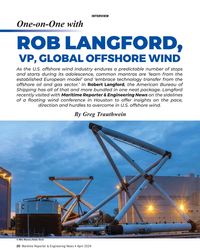 )
April 2024 - Maritime Reporter and Engineering News page: 20
)
April 2024 - Maritime Reporter and Engineering News page: 20INTERVIEW One-on-One with ROB LANGFORD, VP, GLOBAL OFFSHORE WIND As the U.S. offshore wind industry endures a predictable number of stops and starts during its adolescence, common mantras are ‘learn from the established European model’ and ‘embrace technology transfer from the offshore oil and gas
-
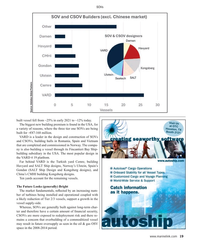 )
April 2024 - Maritime Reporter and Engineering News page: 19
)
April 2024 - Maritime Reporter and Engineering News page: 19SOVs Source: Intelatus Global Partners built vessel fell from ~25% in early 2021 to ~12% today. Visit Us The biggest new building premium is found in the USA, for at OTC Houston, TX a variety of reasons, where the three tier one SOVs are being Booth 2121 built for ~€87-168 million. VARD is a leader in
-
 )
April 2024 - Maritime Reporter and Engineering News page: 18
)
April 2024 - Maritime Reporter and Engineering News page: 18MARKETS & gas activity returns, we anticipate that supply of the vessels The Question of Emissions to offshore wind projects will reduce, driving demand for ad- Given that SOVs and CSOVs operate in a segment target- ditional CSOVs. ing reduced emissions, and many operate in the North Eu- Outside of China
-
 )
April 2024 - Maritime Reporter and Engineering News page: 16
)
April 2024 - Maritime Reporter and Engineering News page: 16MARKETS SOVs – Analyzing Current, Future Demand Drivers By Philip Lewis, Director of Research, Intelatus © Björn Wylezich/AdobeStock t a high-level, there are three solutions to transferring Lower day rate CTVs are often used for daily transfer of technicians from shore bases to offshore wind farms
-
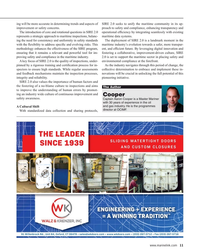 )
April 2024 - Maritime Reporter and Engineering News page: 11
)
April 2024 - Maritime Reporter and Engineering News page: 11ing will be more accurate in determining trends and aspects of SIRE 2.0 seeks to unify the maritime community in its ap- improvement or safety concerns. proach to safety and compliance, enhancing transparency and The introduction of core and rotational questions in SIRE 2.0 operational ef? ciency by
-
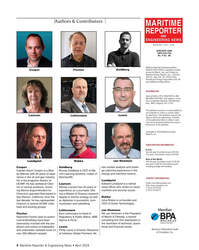 )
April 2024 - Maritime Reporter and Engineering News page: 4
)
April 2024 - Maritime Reporter and Engineering News page: 4Authors & Contributors MARITIME REPORTER AND ENGINEERING NEWS M A R I N E L I N K . C O M ISSN-0025-3448 USPS-016-750 No. 4 Vol. 86 Maritime Reporter/Engineering News (ISSN # 0025-3448) is published monthly Cooper Fischer Goldberg except for March, July, and October by Maritime Activity Reports, Inc.
-
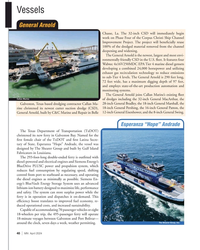 )
April 2024 - Marine News page: 40
)
April 2024 - Marine News page: 40Vessels General Arnold Chasse, La. The 32-inch CSD will immediately begin work on Phase Four of the Corpus Christi Ship Channel Improvement Project. The project will bene? cially reuse 100% of the dredged material removed from the channel deepening and widening. The General Arnold is the newest,
-
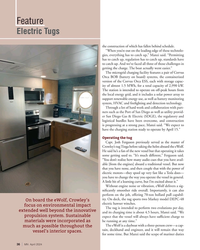 )
April 2024 - Marine News page: 36
)
April 2024 - Marine News page: 36Feature Electric Tugs the construction of which has fallen behind schedule. “When you’re out on the leading edge of these technolo- gies, everything has to catch up,” Manzi said. “Permitting has to catch up, regulation has to catch up, standards have to catch up. And we’ve faced all three of those challenge
-
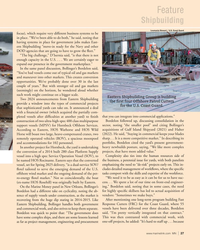 )
April 2024 - Marine News page: 27
)
April 2024 - Marine News page: 27Feature Shipbuilding Loumania Stewart / U.S. Coast Guard focus), which require very different business systems to be in place. “We’ve been able to do both,” he said, noting that having systems in place for government jobs makes East- ern Shipbuilding “move-in ready for the Navy and other DOD agencies
-
 )
February 2024 - Maritime Reporter and Engineering News page: 44
)
February 2024 - Maritime Reporter and Engineering News page: 44Tech Files Latest Products & Technologies MarineShaft Yanmar Hydrogen MarineShaft specializes in urgent re- Fuel Cell AIP pair/replacement of damaged rudder and Yanmar Power Technology Co., Ltd. propeller equipment along with many (Yanmar PT), a subsidiary of Yanmar on-site repair services. MarineShaft
-
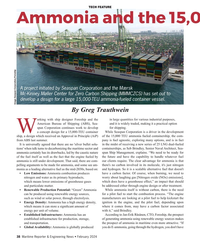 )
February 2024 - Maritime Reporter and Engineering News page: 38
)
February 2024 - Maritime Reporter and Engineering News page: 38TECH FEATURE Ammonia and the 15,00 A project initiated by Seaspan Corporation and the Mærsk Mc-Kinney Møller Center for Zero Carbon Shipping (MMMCZCS) has set out to develop a design for a large 15,000-TEU ammonia-fueled container vessel. Image Seaspan Corporation/Foreship By Greg Trauthwein orking with
-
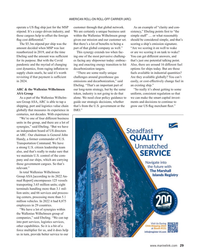 )
February 2024 - Maritime Reporter and Engineering News page: 29
)
February 2024 - Maritime Reporter and Engineering News page: 29AMERICAN ROLL-ON ROLL-OFF CARRIER (ARC) operate a US ? ag ship just for the MSP customer through that global network. As an example of “clarity and con- stipend. It’s a cargo driven industry, and We are certainly a unique business unit sistency,” Ebeling points ? rst to “the those cargoes help to
-
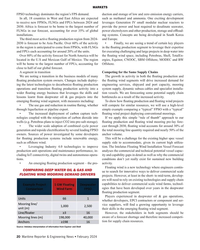 )
February 2024 - Maritime Reporter and Engineering News page: 20
)
February 2024 - Maritime Reporter and Engineering News page: 20MARKETS FPSO technology dominates the region’s FPS demand. duction and storage of low and zero emission energy carriers, In all, 18 countries in West and East Africa are expected such as methanol and ammonia. One exciting development to receive new FPSOs, FLNGs and FPUs between 2024 and leverages
